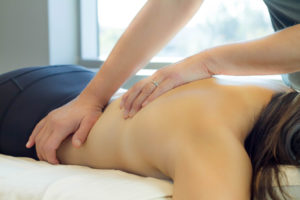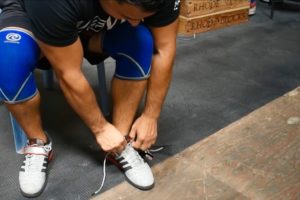There has been a lot of chatter about blood flow restriction (BFR) training going around the rehab and fitness world these days. I’ve heard promising things coming out of the rehab end of this and wanted to know more. I also wanted to know about its place in fitness, if individuals were using it in gyms, to what extent and what for?
What is BFR training? BFR training is using an apparatus (cuff, elastic wrap) to wrap around a limb creating venous but not arterial occlusion and then weight lifting or performing aerobic exercise with it on. Why? What is the purpose? A lot of the literature on BFR training has shown that it can help induce muscle hypertrophy with low load training. Wait, what does that mean? That means that while using this modality you can create muscle growth using loads that traditionally would not be intense enough to stimulate growth in the muscle. WHAT?? Yep, you can gain muscular size and strength using smaller loads! Done, sign me up. Wait, are there risks with this?
Of the risks that have been of concern are:
- Increased chances of thrombus formation (blood clots)
- Increased muscle damage
- Blood pressure change
- Nerve conduction
That means that while using this modality you can create muscle growth using loads that traditionally would not be intense enough to stimulate growth in the muscle.
Studies have shown that increased blood clots are not high risk with this modality due to the fact that clotting factors have not been shown to increase with implementation of a BFR program. Increased muscle damage is always a concern with resistance training but the low loads used in BFR are just that, too low to really induce muscle damage. Blood pressure fluctuations are also always a concern with resistance training and when occluding blood vessels it appears that there is slight inherent risk; although this mostly pertains to individuals that already have complicated cardiovascular problems. If you already have cardiovascular problems it would be best to check with your local healthcare practitioner before initiating a BFR training program. A loss in nerve conduction and numbness/tingling has been shown to be a risk with BFR training but is transient and has to do more with inappropriate tightness of the apparatus used or placement. Both can be handled by either loosening up the the apparatus to appropriate pressure or placement of it.
Excellent, so now we’ve gone over what BFR can be used for and the risks, how do I do it? BFR training can be performed:
- 2-3 days per week
- At intensities of 20-30% of your 1RM max.
Studies have shown that increased blood clots are not high risk with this modality due to the fact that clotting factors have not been shown to increase with implementation of a BFR program.
The set and rep scheme that has been shown to stimulate muscle growth with BFR is 75 reps broken into 4 sets. The goal is accumulation of lactic acid and metabolite in the muscle which stimulates increased growth hormone production and a physiological cascade that will release more hormones and proteins associated with muscle growth.
- The four sets are broken up in 30/15/15/15 with 30 seconds of rest between sets.
This training program has been demonstrated to create muscle hypertrophy in approximately four weeks and improved strength in approximately ten weeks.
There’s good news out there for you aerobic athletes as well. There have been studies using BFR training the have demonstrated improvements in VO2 max, onset of blood lactate accumulation, max power output, and strength. The body of evidence for using BFR training for aerobic athletes isn’t as large as it is for strength training but it is showing promising results. Again, there are the same inherent risks and before implementation of a BFR regime, checking with your local healthcare provider might be prudent. BFR training for aerobic fitness, just like for strength, can be performed:
- 2-3 days per week at a lower intensity than is traditionally used for improvements in performance. A few of the studies I researched had individuals:
- Working at 40% VO2 max or 30% heart rate reserve as a stimulus to see improvements in capacity.
- Training regimes varied from 10-30 minutes of aerobic exercise at this intensity; but the most widely used protocols call for at least 15 minutes per session.
Good deal, now where do I restrict blood flow at and how tight do I need to make the restriction? Now, devices can be bought that will measure pressure and be pumped up to 50% occlusion for the upper body and 80% for the lower body. This corresponds to a perceived tightness of 4-5/10 for the arm and 6-7/10 for the leg. Bands or cuffs are best placed around the upper arm or upper leg for adequate occlusion and to avoid superficial nerve compression that would cause numbness or tingling.
So there you have it, BFR looks to be very promising for increasing lean muscle mass and improving aerobic capacity using lower intensities than would traditionally be used as a stimulus to create such change. It also seems that BFR can be used with little health risks posed or adverse effects from the training. It can also be implemented with simple, easy to use pieces of equipment and for rehab, fitness, and performance purposes.
So there you have it, BFR looks to be very promising for increasing lean muscle mass and improving aerobic capacity using lower intensities than would traditionally be used as a stimulus to create such change.
As always, I hope this helps! If you have any questions or would like to read about certain topics, send us an email at TeamSP@SportsPerformancePT.com.
-Dr. Nick Schroeder, PT, DPT, CSCS
For more tips on optimizing athletic performance FOLLOW US on:
- Instagram: http://www.instagram.com/SportsPerformancePT
- Facebook: http://www.facebook.com/SportsPerformancePT
- YouTube: http://www.youtube.com/c/SportsPerformancePT










